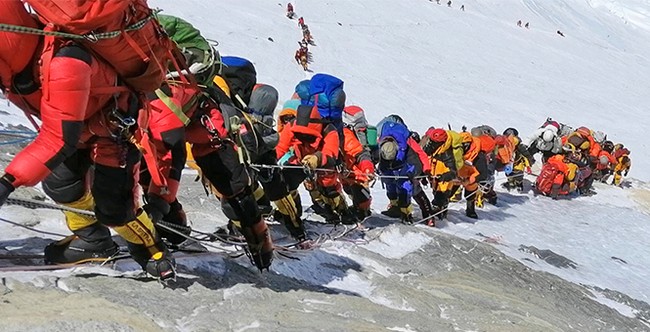We support our Publishers and Content Creators. You can view this story on their website by CLICKING HERE.

When we contemplate human evolution, there’s a tendency to reverse-engineer our bodies so they tell the story of man competing against wild animals.
We became endurance hunters so we could track down an injured deer. We became experts at detecting motion so we could hunt small game. We lost our body hair so we could travel long distances without overheating. We developed dexterous arms, shoulders, thumbs, and hands so we could strike animals with spears and weapons. And even today, we are instinctively fearful of snakes and poisonous bugs — which certainly seems to make evolutionary sense. We were shaped by our environment; that’s why we look like we do!
Advertisement
But get ready for a curveball: I’m going to convince you that human evolution has very little to do with the local wildlife. (More in a moment.)
One of the strangest human adaptations took place a scant 9,000 years ago on the Tibetan Plateau. DNA testing of the Sherpa and Tibetan populations indicates that a series of very specific genetic modifications took place. The Sherpas, who had lived for thousands of years in extreme elevations, had developed what Cambridge University called “superhuman energy efficiency.”
Scientists have known for some time that people have different responses to high altitudes. While most climbers require additional oxygen to scale Mount Everest, whose peak is 8,848m above sea level, a handful of climbers have managed to do so without. Most notably, Sherpas, an ethnic group from the mountain regions of Nepal, are able to live at high altitude with no apparent consequences to their health — as a result, many act as guides to support expeditions in the Himalayas, and two Sherpas are known to have reached the summit of Everest an incredible 21 times. [emphasis added]
It’s a fascinating study. But I’m less interested in its medical and/or genetic conclusions than the question they failed to answer: What the hell were the Sherpas doing on the top of a cold, brutal mountain for 9,000 years?
Evolution is slow. It takes a lot of time. And 9,000 years ago, there were only about five million humans on the whole planet! A desolate, extreme environment like the Tibetan Plateau was almost entirely devoid of large human settlements. That whole region was bereft of people.
Advertisement
So, why would humans stay on the top of a frigid, inhospitable mountain range when the rest of the world was underpopulated?
Why not just leave the mountain? Wouldn’t it be nicer to live closer to sea level — or even have a home next to the sea? You could fish! You could bathe! Your resources would vastly increase. Best of all, you could leave your cave without freezing to death.
On the other hand, a benefit of living atop an icy mountain might’ve been the ability to preserve meat. If you hunt and kill a large animal, the ice and snow might let you and your family dine on one carcass for weeks at a time. The Tibetan antelope, snow leopard, Tibetan blue bear, blue sheep, Tibetan fox, and Tibetan gazelle are all native to that region. When cooked over an open fire, I’m sure they’re quite tasty.
So, game preservation is a possibility. I just don’t think it’s the right answer.
Preserving game meat is critically important when food is scarce. But had the Sherpas lived in a warmer, sea-level climate, the amount of available food would’ve been significantly greater, and preserving meat would’ve been a nonissue. Even today, Pacific Islanders are able to subsist wholly on the ocean’s bounty. The people in Tahiti and Hawaii seem to survive just fine without freezing their meat — or even having ice — and they’re not alone. Historically, humans spurned the cold and sought climates that were warmer and more conducive for survival.
Advertisement
Perhaps the Sherpas stayed where they were for 9,000 years because there were predatory animals that attacked them when they traveled south. That’s a possibility, too: perhaps they were stuck. I don’t think it’s the right answer, either, but it’s closer to what probably is the correct explanation.
I believe the reason why the Sherpas stayed on the top of a mountain for so long that they developed evolutionary adaptations wasn’t because something was going to kill them, but someone. And the reason why they didn’t descend from the mountaintop and relocate near the water was because it wasn’t safe to do so. Why?
Because other humans would kill them.
Our ability to be endurance hunters? Or throw weapons? Or detect motion at a distance? We didn’t develop these skills because of lions, tigers, and bears. Instead, the primary driver of human evolution was murderous, evil, untrustworthy humans. We have met the enemy, and it is us.
Historically, what do you think led to the greatest number of human deaths: Lions, tigers, bears, snakes, and shark attacks combined, or other humans? The answer is almost certainly other humans — and by a ridiculously (and depressingly) wide margin. Nine thousand years ago, if you couldn’t defend your family from human predators, you’d be murdered, your children slaughtered, and your women raped. You’d be excised from the human bloodline. It’s barbaric and disgusting, but this exact same scenario took place hundreds of thousands of times. Maybe even millions.
Advertisement
And that’s why the scariest genetic modification in human history is the Sherpas. This isn’t something we can blame on the Neanderthals, Denisovans, or Homo erectus. This was purely human: We were the monsters.
Arguably, we still are.

 Conservative
Conservative  Search
Search Trending
Trending Current News
Current News 






